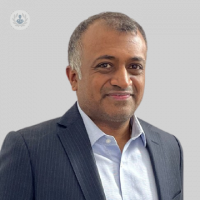Beating the odds: innovative approaches and technologies in arrhythmia management
Autore:It’s believed that arrhythmias occur due to abnormal electrical impulses in the heart, but what can be done to manage them?
Cardiologist Dr Sujay Chandran speaks to Top Doctors about the latest innovative approaches and technologies available to treat arrhythmias, while also discussing the causes of these irregular heart rhythms and why it's crucial to explore non-invasive treatments before considering more advanced interventions.

What is arrhythmia and why does it occur?
Arrhythmia occurs when the electrical signals that coordinate the heart's beats are disrupted. This disruption can lead to a variety of symptoms, including palpitations, dizziness, shortness of breath, and fatigue. While some arrhythmias are harmless, others can lead to severe complications such as stroke or heart failure.
Common causes of arrhythmia include:
- Coronary artery disease.
- High blood pressure.
- Congenital heart defects.
- Stress or anxiety.
- Excessive alcohol or caffeine consumption.
How is arrhythmia traditionally treated?
Traditionally, arrhythmia treatment focused on controlling the heart rate and rhythm using medications, cardioversion (electrical shock to reset the heart), or implantable devices like pacemakers.
However, these approaches, while effective, were often long-term and focused on symptom management rather than addressing the underlying cause.
What are the latest innovations in arrhythmia management?
New technologies and approaches have transformed arrhythmia management, offering more precise, personalised, and often less invasive options. Below are some of the most promising developments.
- Catheter ablation
Catheter ablation is an advanced procedure used to treat certain types of arrhythmias, such as atrial fibrillation. During this procedure, a catheter is inserted through a vein in the groin and guided to the heart. Using radiofrequency energy, the areas of the heart responsible for the abnormal rhythm are destroyed.
Recent advancements have made ablation more accurate, reducing the risk of recurrence and complications. For example, the use of 3D mapping technology allows for detailed visualisation of the heart, making the procedure more effective.
- Cryoablation
Cryoablation is an alternative to traditional ablation that uses extreme cold to destroy abnormal heart tissue. This method is often used in patients who do not respond to or are not candidates for other treatments. It is a minimally invasive procedure, offering shorter recovery times and fewer risks than traditional surgical options.
- Wearable Devices
Wearable devices such as smartwatches are now capable of monitoring heart rhythms in real-time. These devices can detect irregular heartbeats and alert the patient or their healthcare provider. Continuous monitoring through wearables enables early detection of arrhythmias, which is essential for timely intervention.
Some wearable devices are also equipped with AI-driven algorithms, which help predict and identify arrhythmia episodes more accurately than traditional monitoring methods.
- Leadless pacemakers
Traditional pacemakers require leads, which are thin wires that connect the device to the heart. These leads can occasionally cause complications, such as infections or lead displacement. Leadless pacemakers are a newer alternative that do not require these wires.
These devices are implanted directly into the heart and offer the same function as traditional pacemakers, with fewer risks and a more streamlined insertion process.
- Electrophysiology robots
Robotic-assisted procedures are becoming more common in arrhythmia treatment. These robots assist cardiologists in performing complex procedures with greater precision. Robotic systems are particularly useful in catheter ablation, where precise movements can help target and eliminate the source of arrhythmia more effectively, reducing the chance of error.
How does artificial intelligence (AI) improve arrhythmia treatment?
AI is playing a growing role in the diagnosis and treatment of arrhythmias. AI-driven algorithms can analyse vast amounts of data from wearables, heart monitors, and medical records to identify patterns that may be missed by human interpretation. This allows for earlier diagnosis, more personalised treatment plans, and even predictive capabilities that can forecast when an arrhythmia episode may occur.
In addition, AI is being integrated into electrophysiology studies, helping doctors to create more accurate models of a patient's heart. These models can guide procedures, such as ablation, with a higher success rate.
What does the future of arrhythmia management look like?
The future of arrhythmia management will likely see more widespread use of AI, robotics, and wearable technologies. Furthermore, advancements in genetic therapy could potentially address the root cause of arrhythmias at the molecular level, offering a permanent solution for certain types of arrhythmias.
Remote monitoring and telemedicine are also expected to become more prevalent, allowing patients to manage their condition from home while staying connected to their healthcare team.
If you’d like to explore innovative treatments for arrhythmias in-depth, arrange a consultation with Dr Sujay Chandran via their Top Doctors profile.


